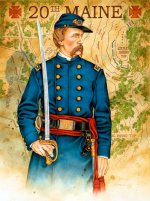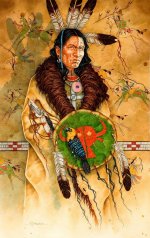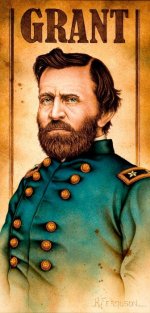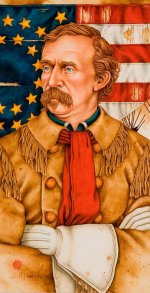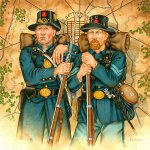U.S. Grant was acknowledged by his peers as a self-assured and determined general. Said General William T. Sherman:
"It will be a thousand years before Grant's character is fully appreciated. Grant is the greatest soldier of our time if not all time... he fixes in his mind what is the true objective and abandons all minor ones. He dismisses all possibility of defeat. He believes in himself and in victory. If his plans go wrong he is never disconcerted but promptly devises a new one and is sure to win in the end. Grant more nearly impersonated the American character of 1861-65 than any other living man. Therefore he will stand as the typical hero of the great Civil War in America."
This painting depicts General Grant in 1863, at the time of his doggedly determined Vicksburg campaign. After a number of failed attempts to take this "Gibraltar of the Confederacy," Grant determined that he would march his armies on the western side of the Mississippi River and cross far south of the city, which entailed cutting his army loose from its supply line. This was a bold but successful move that sealed the fate of the Confederacy's last major hold on the Mississippi River and was acknowledged as such by President Abraham Lincoln:
"I do not remember that you and I ever met personally. I write this now as a grateful acknowledgement for the almost inestimable service you have done the country. I wish to say a word further. When you first reached the vicinity of Vicksburg, I thought you should do, what you finally did--march the troops across the neck, run the batteries with the transports, and thus go below; and I never had any faith, except a general hope that you knew better than I, the Yazoo Pass expedition and the like could succeed. When you got below, and took Port-Gibson, Grand Gulf, and vicinity, I thought you should go down the river and join Gen. Banks; and when you turned Northward East of the Big Black, I feared it was a mistake. I know wish to make the personal acknowledgement that you were right, and I was wrong. Yours Very Truly, A. Lincoln.''
As is often the case with men of strong military character, Grant was a devoted family man. He and his wife Julia had four children, which he is said to have spoiled to a fault. While it is often remarked that Grant had a drinking problem, research shows that he was provoked to drink primarily by boredom and desperate loneliness in the face of separation from his family during the long hard days of the war. Grant did not imbibe when the campaigning was active, or when reunited with his family.
Copyright Kenneth Ferguson
www.kennethfergusonfineart.com

